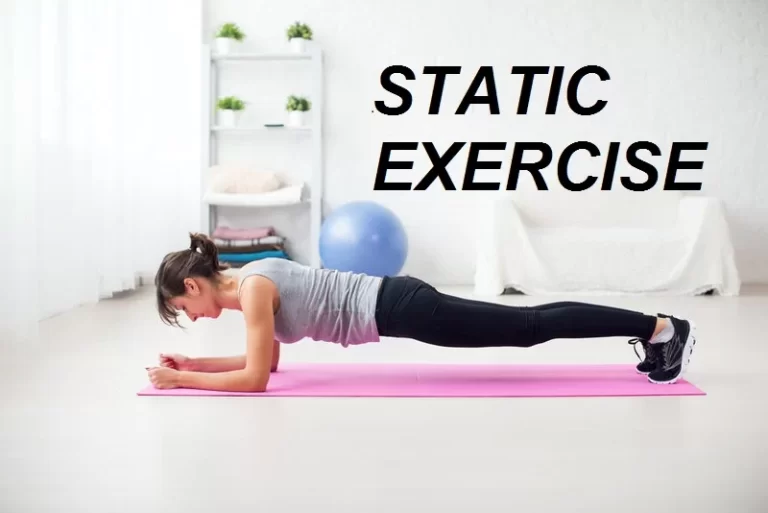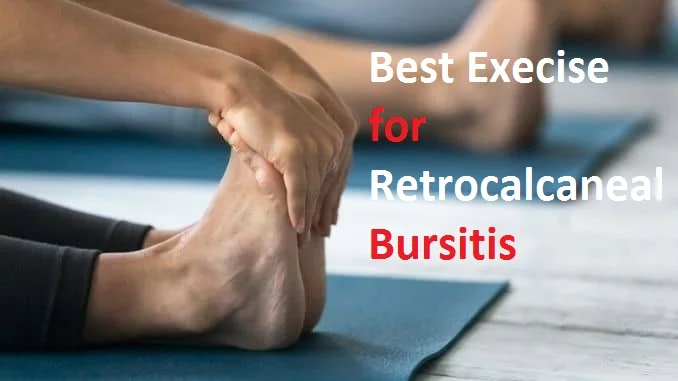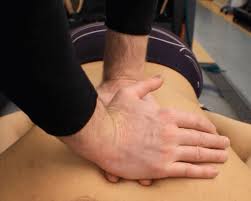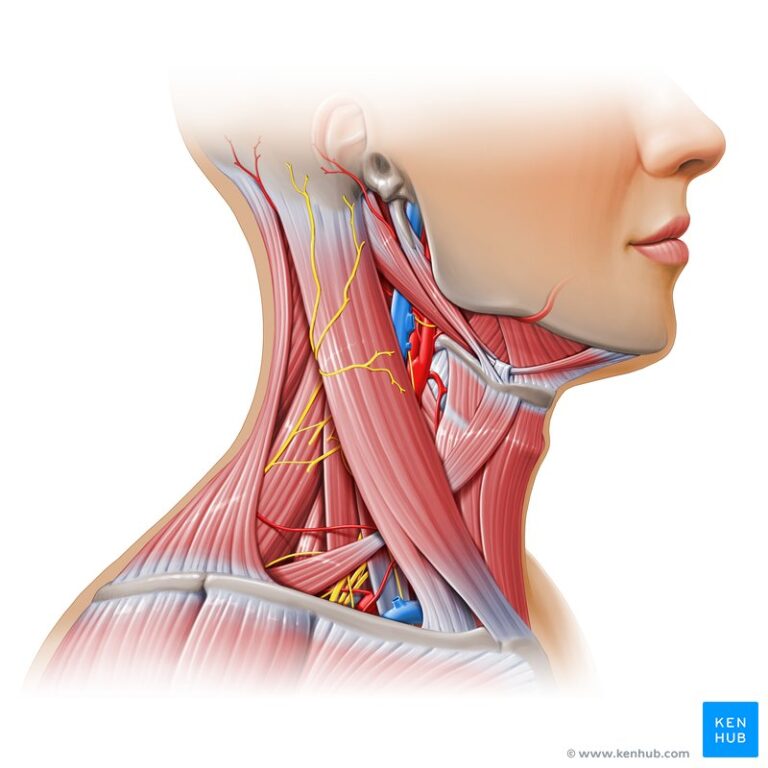Abdominal muscles stretching exercise
Table of Contents
What is abdominal muscle stretching exercise?
- When this comes to daily stretching exercises, the abdominal muscles are often overlooked. However, stretching the abs is good for posture & overall flexibility. Try static stretches, such as cobra, cow, & cat poses. The patient can also perform dynamic stretches, namely, glute bridges as well as side bends. If the patient has an exercise ball, perform full-body extensions to stretch the abs. To avoid injury, warm up before stretching, breathe while you stretch, & avoid deep stretching the same muscle group two days in a row.
- The strong core is an important component of overall fitness, athletic performance, & daily life.
- Abdominal muscle stretching is the best way to increase the flexibility of the lower back & decrease the risk of Back pain & related injury.
The core muscles involve:
- Obliques
- Transverse abdominis
- Rectus abdominis
- Hip flexors
- Pelvic floor
- Diaphragm
- Low back muscles.
- These all work in combination to assist stabilize the spine, prevent back pain, & keep you moving safely.
- Warming up with dynamic stretches before the patient starts the exercise & cooling down with static stretches after you finish the exercise may help.
What are the Health Benefits of stretching the abs?
There are so many benefits of doing abs stretch :
- Prevents low back pain: When this comes to avoiding lower back pain, stretching & strengthening exercises are the best way.
- Decrease the tightness of the muscles, resulting in you an increased range of motion.
- Improves flexibility & mobility: Stretching the muscle after a workout may help increase flexibility as well as mobility.
- Boosts recovery-By stretching the abs, the patient helps the muscles back to full motion & recover faster so you can work out again soon.
- Brace the body for exercise: Doing dynamic stretches, stretches based on the motion before you work the outlet of the abdominal muscles to warm up & to get prepared for the activity ahead.
- Improve posture: This muscle helps you in breathing, so it is important to be healthy.
What are the types of abs stretch?
There are some different types to stretch abs:
- Cobra Pose abdominal stretch
- Cat-Cow Stretch
- Seated side-straddle stretch
- Chest opener on an exercise ball
- Ab Side Stretch
- Supine Stretch
- Slow Cyclone For Abs
- Locust Pose
- Leaning Lifting Crunch
- Kneeling Spinal Wave
- Seated Rotation
- Bow Pose
- Twisting Shoulder Bridge
Cobra Pose abdominal stretch
- How to do this stretching exercise: Lay face down on the floor or on the exercise mat. It is the starting position.
- Place both hands near the shoulder, elbows are bent.
- With the hips flat on the ground, push the torso upward, during gazing straight ahead.
- It will stretch the abdominal muscles.
- Hold the cobra pose for 20 seconds, then back to the embarking position.
- Repeat 2- 4 times.

Cat-Cow Stretch
- How to do this stretching exercise: Get all four limbs in position, & draw the head down as you arch the back, the same as the cat does.
- Stretch the neck all the way upwards, & sink the belly all the way downwards, stretching the abdominal muscles.
- Hold this abs stretch for 20 seconds, then back to the beginning position.
- Repeat 2- 4 times.

Seated side-straddle stretch
- How to do this stretching exercise: Sit upright on the floor with the legs apart.
- Lift the arms to the side with the elbows flexed & fingers pointing upward.
- Use the abdominal muscles & slowly bend sideways to the left, bringing the left elbow towards the ground.
- Do not flex forward or rotate. The patient can feel the stretch through the obliques.
- Hold the abs stretch for 20 to 30 seconds, then back to the beginning position.
- Repeat on the right side and hold for 20 to 30 seconds.
- Repeat 2 to 3 times on both sides.
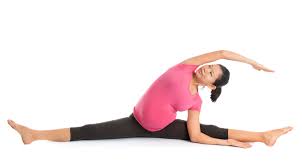
Chest opener on an exercise ball
- How to do this stretching position: Take the lying position on the exercise ball.
- The scapulae, neck, & head should be on the top of a ball, with the back extended, feet flat on the floor, & knees bent at 90-degrees.
- Start the stretch by opening up the arms & letting them drop to the side of a ball.
- Make sure the patient is looking up at the ceiling.
- Hold the stretch for 20-30 seconds.
- Repeat 3-4 times.
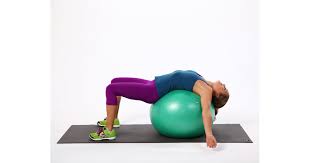
Ab Side Stretch
- How to do this stretching exercise: Stand tall with the feet shoulder-width apart with the arms on either side. Raise the left arm in the air, keeping the right arm by the side.
- Slowly lean over to the right, sliding the right arm down the side.
- In this pose, the patient should feel the stretch through the obliques.
- Slowly back to the original position & place both hands on either side.
- Repeat the ab stretch, this time raising the right arm in the air.
- Pause 8-10 seconds per side.
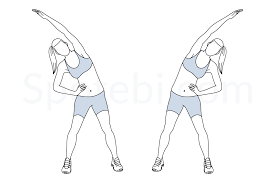
Supine Stretch
- How to do this stretching exercise: Take the lying position on the mat.
- Then lift the arms & reach it over the head with the fingers pointing away from the body.
- Stretch by the spine & move away from the head.
- Pause the supine stretch for 8 – 10 seconds.

Slow Cyclone For Abs
- How to do this stretching exercise: It is dynamic ab stretching. Then, stand tall with the feet shoulder-width apart & keep the mild bend in the knees to keep them soft.
- Stand upright & lift both of your arms in the air.
- Circle the torso from the hips upwards so that the trunk moves in a round movement.
- As the patient performs, keep the arms parallel with the trunk & do the stretch in continuous movement.
- The duration of the stretch is 15 seconds.
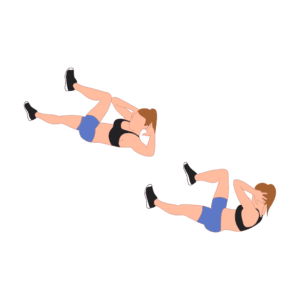
Locust Pose
- How to do this stretching exercise: Begin by lying in the prone position with the arms at the side, positioned against the side of the legs.
- Raise the chest & the legs making the boat shape, so the patient has an inward curved back.
- Release & come back lower to the floor.
- Hold the boat pose for 10 seconds.
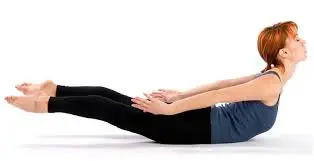
Leaning Lifting Crunch
- How to do this stretching: Take the standing position shoulder-width apart, & make the prayer pose by holding the palms together.
- Lift the arms above the head, imitating the upper half of the tree pose.
- Lean over to the right until the patient feels the stretch in the obliques.
- Next, move the torso by leaning to the left, the time kicking the lifted leg out to the side at the same time.
- Repeat on one side for 20-30 seconds then switch to the other side & repeat.
- The holding time of this abs stretch is 30 seconds on each side, with rest in between.

Kneeling Spinal Wave
- How to do this stretching exercise: Start on the hands & knees. Obtain balance & get comfortable on the mat.
- Push back so the arms are flat in front of you & the head is lower.
- In this pose, the patient should be seated on the knees with a straight back.
- From this position, push up into the ‘cat’ position before transferring into the ‘cow’ position
- Then, push forward into the cobra pose, with the feet soles upward, legs extended & the chest as well as torso upright.
- Push back into the ‘cat’ pose & repeat the movement.
- The duration of the stretching is 30 seconds.

Seated Rotation
- How to do this stretching exercise: Take the sit on the chair with the spine neutral.
- Rotate the body to the right side & pause the position.
- Then turn on the left side as well as pause.
- Hold the rotation for 20-30 seconds.

Bow Pose
- How to do this stretching exercise: Embark on the stretch by lying on the stomach with the knees together & flexing at a 90-degree angle.
- Lift the chest as well as stomach off the floor while keeping the pelvis & thighs on the floor.
- Move the arms backward & grab the ankles as you pull the legs up & push the chest out.
- Keep the neck stable with the spine by looking at a wall in front of you while the whole stretch.
- Hold the abs stretch for 30 seconds & then slow down the upper body as well as legs to the floor.

Twisting Shoulder Bridge
- How to do this stretching exercise: Lie supine on the ground.
- Bend both knees & drag the heels towards the hips. The arms by the sides.
- Now thrust the hips up towards the sky, the feet touching the floor.
- Keeping the left arm on the floor, reach for the left heel.
- Then, rolling over onto the left shoulder, reach the right arm back & over the head.
- Switch to the other side and repeat.

What are the common mistakes to avoid while abs stretch?
There are some mistakes the patient should not do during abs stretch:
- Overstretching: Overstretching while this abdominal stretch could raise the risk of injury & even pulling the muscle, most likely in the obliques. The patient has to stretch the muscle enough that you feel the stretch only & nothing more, but the patient should stop stretching the muscle as soon as he feels any pain.
- Overarching the back: Overarching the back puts extra stress on the muscles in the trunk, as well as the thighs & hamstrings.
- Bending the knees too much: By over-bending the knees, the patient will put extra pressure on the legs, particularly the knees, which could cause pain as well as aches. Standing in this wrong position could also make the stretch unnecessarily difficult, the amount of time that the patient can experience it and as a result, make it less effective.
- Leaning too far over laterally: Leaning too far while abs stretch causes a rise in the risk of injuries by giving extra strain to the obliques.
- Instead, move in a comfortable yet stretching circular movement.
- Going too slow: It is one of the ab stretches that needs to be done at a moderate speed. The crunching action should be slow as well as controlled motion as moving too fast would put a strain on the obliques.
- Putting the head on a ball: The patient does not need to overextend the back & have the lower back on the ground as it could cause backache as well as strain. Instead, assure the patient has the shoulders & lower back raised onto the ball for optimal support.
- Pushing from the toes: Pushing from the toes may be dangerous & give strain to the legs & back.
- Moving too quickly: Stretching is slow-motion, & rushing will not allow the patient to feel the full advantages of ab workout stretches.
- So avoid rushing through this motion, take it slow and assure that you feel the muscles stretching.
- Bending the knees: In standing abs stretch, the patient has to stand up with the knees straight when doing this ab stretch. Bending the knees will risk the stretch & ultimately give unnecessary pressure on the legs as well as the knees.
What are the safety tips during the abs stretch?
There are so many guidelines you need to follow while stretching:
- Avoid quick movements: Avoid performing any fast or jerky motions during stretching. It involves bouncing during moving through & holding the stretch.
- Only went as far as you could: During any type of stretching, this aims to only go to the point of tension. If the patient goes beyond this, you rise the potential for injury.
- Decrease the range of motion if the abs hurt: If the patient is feeling too much tightness or even discomfort in the trunk area, go easy on the stretching, & consider decreasing the range of motion. The patient does not have to perform the full range of movements to benefit from stretching.
- Warm-up for 8 to 10 minutes before stretching: A mild warm-up activity will get the blood pumping, prepare the muscles for stretching, & avoid injury. A brisk walk, jumping jacks, light jog, & other aerobic exercises are great warm-ups. This is also better to stretch after a workout.
- Do not bounce while the patient gives stretching: Hold the stretch stable instead of springing in & out of it. Bouncing when the patient stretch can cause a pulled muscle or another injury.
- Breathe while the perform stretching: Never hold your breath during stretching or even performing any other exercise. Breathe in as you move into the stretch pose, breathe out as he stretches, then inhale again as he returns to the embarking position.
- Stretch muscles for a few minutes 3 times per week. Stretching the same muscle group deeply every day poses an injury risk. Instead, stretch an opposite muscle group per day. Goal to stretch specific muscles for 2 to 3 minutes 2 to 3 days per week.
- Consult the doctor if he has any prior injury. Many individuals are thought that stretching is best if the patient is in pain or has a strained muscle.
- However, stretching the harmed muscle may cause further damage.
- The patient should also consult the doctor before stretching if the patient has a damaged muscle or a history of heart, bone, or joint issues.
FAQ
Does stretching help with abdominal strain?
Compress the area to minimize movement and any swelling. Adductor (groin) stretches and abdominal strengthening exercises are recommended. Rest with periods of light and gentle stretching. See your physician if the pain does not subside within a few weeks.
How do you relieve stomach muscle pain?
Alternate between applying an ice pack and warm compresses to the injured area. Meet with a physical therapist to learn stretching and strengthening exercises. Take nonsteroidal anti-inflammatory drugs (NSAIDs) to ease pain and inflammation. Wear an abdominal brace to support the stomach muscles and minimize swelling.
What does abdominal muscle pain feel like?
If you have an abdominal strain, the surface of your stomach area may feel tender and inflamed. You’re more likely to feel these sensations when you’re contracting your abdominal muscles and moving. Other symptoms include sudden sharp pain.
How do you know if it’s muscle pain or organ pain?
Because many nerves supply the muscles, bones, and other soft tissues, somatic pain is usually easier to locate than visceral pain. Somatic pain also tends to be more intense. The nociceptors in these tissues pick up sensations related to temperature, vibration, and swelling.
Why are my stomach muscles tight?
A feeling of tightness in a person’s abdomen is usually the result of digestive or hormonal issues. The sensation often goes away on its own, but it can signal an underlying health issue.

